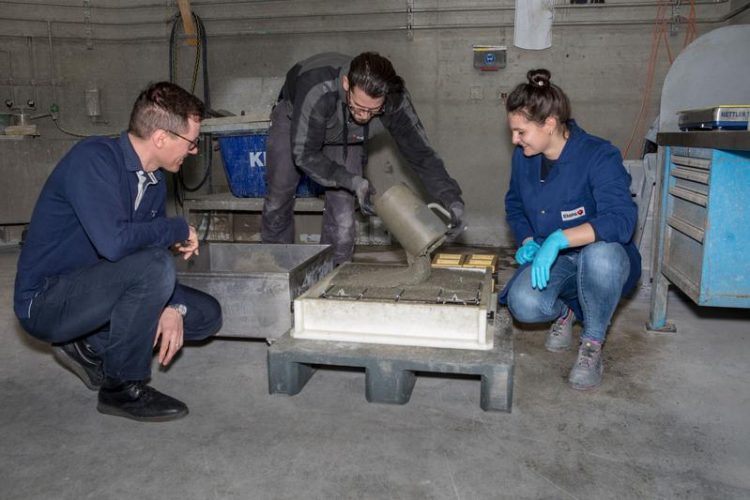When Concrete learns to pre-stress itself

Empa researchers Mateusz Wyrzykowski and Volha Semianiuk, with the help of laboratory technician Sebastiano Valvo, are investigating new possibilities for self-tensioned CFRP concrete elements. Empa
More than ten billion tonnes of concrete are produced and used worldwide every year. This is more than all other building materials combined. By way of comparison, steel and asphalt – both of which are also used very abundantly – are each produced at around 1.5 billion tonnes annually.
Even though the energy required to produce one tonne of concrete and the emissions that go with it are lower than for other building mate-rials, the huge quantities are responsible for a significant environmental impact.
Cement, the binding agent in concrete, is the main culprit. Just under three percent of the world’s primary energy is used for the production of four billion tonnes of cement required annually. Cement production is also responsible for up to eight percent of the global CO2 emissions.
According to estimates, the annual production of concrete and cement could even increase by another 50 percent by 2050 due to a growing demand in developing countries. Replacing concrete is not an easy task, though; the building material simply offers too many advantages.
These figures show that a more sustainable use of concrete – from production and efficient use of materials to demolition and recycling – will have an enormous impact on our environment and society.
Patents in Europe and the US
Empa scientists are looking into developing methods to make concrete elements leaner, yet durable and stable, so that materials consumption is reduced. A team led by Giovanni Terrasi, Pietro Lura and Mateusz Wyrzykowski was recently granted a European and a US patent for a self-pre-stressing concrete technology that achieve just this.
Pre-stressing is generally used when a concrete element has to withstand very high loads – for instance, beams, bridges or cantilevered structures. In a conventional pre-tensioning technology, the reinforcements or tendons – usually made of steel – are anchored on both sides of the element before the concrete is cast, put under tension and re leased again after the concrete has set.
The forces generated in the tendons place the concrete under compressive stress: The element is pulled together by the pre-tensioned reinforcement on its inside, so to speak – and is thus much more stable. The problem: Steel is susceptible to corrosion. Therefore, the concrete layer around the pre-stressing steel must have a certain thickness.
Carbon Fibres instead of Steel
As early as in the 1990s, carbon fiber-reinforced polymers (CFRP) were used to replace steel reinforcement. Because CFRP does not corrode, it is possible to produce significantly leaner concrete components – with very similar structural properties.
“But if you want to pre-stress these CFRP reinforcements in order to be able to build even thinner structures with a higher load-bearing capacity, you reach your limits,” says Wyrzykowski. Very expensive pre-stressing beds are required and the anchoring of CFRP bars is much more complicated than that of steel. Thus, pre-stressed CFRP high-performance concrete is still not very widely used.
Expanding Concrete
The Empa team has now succeeded in completely dispensing with anchoring on both sides of the concrete element, as the concrete does the work by itself: Thanks to a special formula, the concrete expands as it hardens. As a result of this expansion, the concrete puts the CFRP bars in its interior under tension and thus automatically pre-stresses itself.
In their laboratory tests, the researchers were able to show that the self-pre-stressed CFRP concrete elements could bear loads comparable to those that were conventionally pre-stressed – around three times more than a non-pre-stressed CFRP concrete element.
“Our technology opens up completely new possibilities in lightweight construction,” says Wyrzykowski. “Not only can we build more stable structures, we also use considerably less material.” The Empa researcher also envisions completely new fields of application:
“We can easily pre-stress in several directions at the same time, for example for thin concrete slabs or filigree curved concrete shells,” he says, looking to the future. These new applications are now being developed further in cooperation with industry partner BASF.
Dr. Mateusz Wyrzykowski
Concrete & Asphalt
Phone +41 58 765 45 41
mateusz.wyrzykowski@empa.ch
Editor / Media contact
Stephan Kälin
Communication
Phone +41 58 765 49 93
redaktion@empa.ch
Media Contact
All latest news from the category: Architecture and Construction
Newest articles

First-of-its-kind study uses remote sensing to monitor plastic debris in rivers and lakes
Remote sensing creates a cost-effective solution to monitoring plastic pollution. A first-of-its-kind study from researchers at the University of Minnesota Twin Cities shows how remote sensing can help monitor and…

Laser-based artificial neuron mimics nerve cell functions at lightning speed
With a processing speed a billion times faster than nature, chip-based laser neuron could help advance AI tasks such as pattern recognition and sequence prediction. Researchers have developed a laser-based…

Optimising the processing of plastic waste
Just one look in the yellow bin reveals a colourful jumble of different types of plastic. However, the purer and more uniform plastic waste is, the easier it is to…



